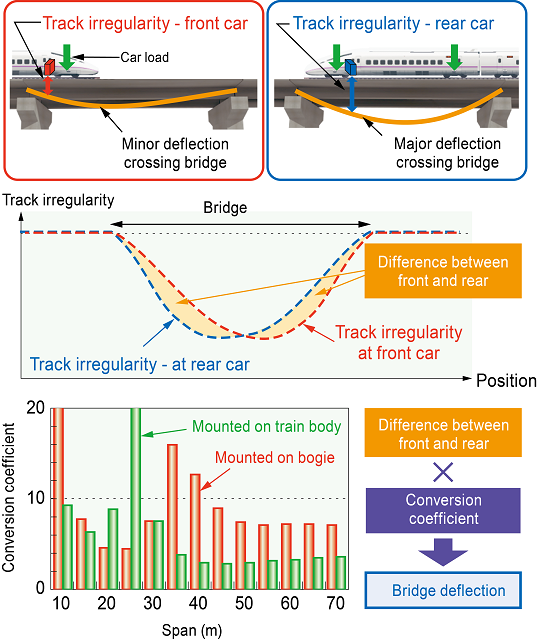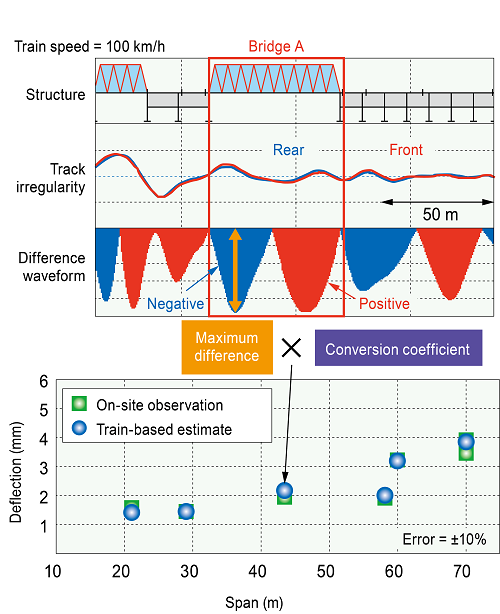11. Tool for estimating bridge deflection from on-board track irregularity measurements
Bridge deflection associated with passing trains is a key indicator used in bridge maintenance work. Traditionally, bridge deflection is measured using on-site instruments for each span in turn. This costly and time-consuming process has effectively prevented ongoing monitoring of bridges through regular measurements of bridge deflection.
Our tool generates an estimate of bridge deflection by calculating the difference between track irregularities measured at the front and rear cars of a moving train set.
In order to estimate bridge deflection using observations taken from a moving train set, we need to determine the correlation between track irregularity and bridge deflection, which varies in accordance with train movement. We also need to isolate the bridge deflection component within track irregularity.
To this end, we first established that bridge deflection is theoretically proportional to the difference in observed track irregularity between the front and rear cars of the train set. We used this to extract the bridge deflection component by eliminating static track irregularity from the difference, then multiplied by the conversion coefficient to produce an estimate for bridge deflection (see Figure 1).
Our tool requires track measuring devices to be installed on the front and rear cars of the train set.
As Figure 2 shows, trials on an in-service railway line indicate that the maximum bridge deflection estimated by the tool is accurate to within approximately 10% of standard on-site observations for train speeds of up to 100 km/h.
This tool can be used to identify bridges subject to significant bridge deflection along each route, and schedule repair work on the basis of ongoing monitoring of bridges.
Other Contents
- 9. Integrated analytics platform for railways
- 10. On-board obstacle detection system suitable for low-light conditions
- 11. Tool for estimating bridge deflection from on-board track irregularity measurements
- 12. Wear measuring apparatus for overhead conductor rail using light sectioning
- 13. Imaging analysis method for detecting various anomalies in overhead contact lines
- 14. Automated crew scheduling system
- 15. Fast-track embankment structure for confined settings
- 16. Numerical analysis method for predicting interaction impacts on closely adjacent tunnels
- 17. Method for evaluating girder vibration characteristics with consideration for track rigidity
- 18. Concrete repair methodology based on crack width and location
- 19. Using expansive concrete in track slabs to minimize reinforcement
- 20. Using temperature sensors to help predict service life of electronic signallingequipment
- 21. Effective and efficient steam weeding technique
- 9. Integrated analytics platform for railways
- 10. On-board obstacle detection system suitable for low-light conditions
- 11. Tool for estimating bridge deflection from on-board track irregularity measurements
- 12. Wear measuring apparatus for overhead conductor rail using light sectioning
- 13. Imaging analysis method for detecting various anomalies in overhead contact lines
- 14. Automated crew scheduling system
- 15. Fast-track embankment structure for confined settings
- 16. Numerical analysis method for predicting interaction impacts on closely adjacent tunnels
- 17. Method for evaluating girder vibration characteristics with consideration for track rigidity
- 18. Concrete repair methodology based on crack width and location
- 19. Using expansive concrete in track slabs to minimize reinforcement
- 20. Using temperature sensors to help predict service life of electronic signallingequipment
- 21. Effective and efficient steam weeding technique


